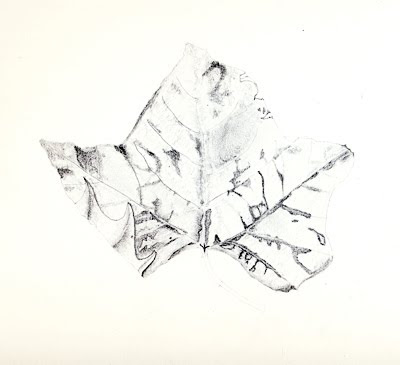Most often, come morning when I review the evening's work, I begin to examine with a critical eye. What looked so exciting the night before has now dulled. Surprisingly, this morning's review gave me a bit of hope. I was ready to toss the mess but now I'll hang on, maybe to continue right along or maybe to table it for later. In the meantime, with five days away from work in front of me, I'll be working on eking out a dedicated playground. :-)
Haha! I just noticed that some shading at the top of the leaf looks curiously like a question mark. How apropos... :-)

Dynamic Light and Shade by Burne Hogarth is a new book in my library. I'm taking it slowly, letting it settle in. Chapter 1 is about black and white silhouette. Depth or the third dimension, light intensity, and perspective are illustrated with many examples and short descriptive paragraphs. I think about these examples as I struggle with all kinds of detail, how a simple but well stated patch of black on a white background can gracefully and succinctly convey the image.


Despite your worries, this the sycamore leaf is coming along just fine!
ReplyDeleteI totally understand your want and need for a "designated work station", as I do not have a real one either, save for a small desk in the corner of the bedroom. But I have developed some methods that have helped me greatly in maintaining consistent lighting and shadowing.
I bought some florists putty and gently attach/position my specimen on a piece of matboard/foamcore (whatever you have) ( if I am painting, my board is neutral grey ) with the putty. . I will also bend the leaves/twigs/flowers to the exact position I want and stick it all into place with tiny bits of putty. I usually then stand this board upright, positioning it towards my light source until I get the shadowing I want. Then I take a digital photo so I can use it for reference (i.e. for shadows and light placement for future drawing sessions). I will also pencil in an arrow on my paper/board towards the light source so that I can hopefully set up everything in exactly the same way next time, using the photo and arrow as guides.
Hope this helps!
~gretchen
Wow Gretchen, thank you for sharing this! Christmas is coming early for me! :-)
ReplyDeleteJust an hour ago I was twisting a beech branch all about, adjusting leaves and turning the whole piece all around while viewing the ever-changing highlights and shadows. I began thinking how many interesting photos were possible during this little exercise. And yet, I never connected the dots--that I could be creating reference photos, or that I could simply jump into a fun photo session. Thank you for lifting me out of my 'stuck' condition.
A couple of questions if I may to help me better understand:
Do you use the reference photos as aids during your drawing and painting sessions or only as guides to help you recreate the model?
Perhaps you sometimes work from ref photos and sometimes from the illuminated model?
Don't get too involved setting up a workspace because then you might not draw. If you are happy drawing in your comfy chair or your bed, you just keep that up, you're learning so very much! - Joyce
ReplyDeleteThanks for the good advice, Joyce. I'll try to hang loose as I pull together all kinds of new ideas. I so appreciate all the wonderful help I'm receiving! :-)
ReplyDeleteMost of the time I try to work from my specimen; but I also use my photos as a supplementary reference while I work as I find sometimes that photos are more contrasty and help me see the over all "abstract shape" of the cast shadows. Also, seeing the subject in a smaller photographic format helps me "see" it with fresh eyes. Another thing is that having the photo(s) is an insurance policy in case something happens to your specimen (sometimes they dry up, or the cat nibbles them!)- then you can still finish that drawing you have hours and days invested in. Plus, like you, if feel like just sketching in my comfy chair for awhile, I grab the photo and do so!
ReplyDeleteHope this helps!
~gretchen
Thank you so much, Gretchen! :-) This really helps!
ReplyDelete